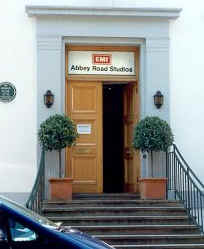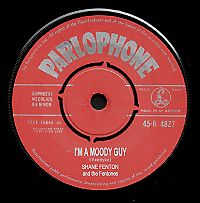|
 |
 |
The basis of this text
is taken from the article "Recording Methods", part of the "Album
That Never Was" page on my Johnny
Kidd and the Pirates site.
|
 |
|
EMI
Studios, Abbey Road |
Although
mono was still King in the UK in the late 1950's (and would remain so
for some years yet) the Abbey Road studios staff were well versed in
recording large orchestras "live" onto a twin-track stereo machine for a
virtually immediate stereo mastered product. The large sound accordingly
filled the spectrum between the left and right channels. For a raw rock
band consisting of four instruments plus singer a similar but economical
"live" method would be employed where a few microphones were set up.
Sometimes it was even more basic: the Capitol Studio where Gene
Vincent's early stuff was recorded featured a single microphone, singer
and instruments being distanced according to their relative volumes.
Later on, the singer would have his/her own mike to help the sound
engineers "lift" the volume of his voice (either during recording or
mixdown) so he could be heard properly.
By
comparison early Rock music was considered not "real" music,
more a passing 'fad' by the
establishment thus it didn't qualify for quite so much time being spent on it.
Typically, a three-hour session would be arranged, enough for both sides
of the next single - often with one or two extra cuts (for an EP or LP,
should sales allow) - time was money, after all. You had to get it right
in the studio as once you captured it on tape, that was basically it.
Later on the widespread use of tape allowed more flexible editing
techniques to be used; a Post-production session could then remove bum
notes and apply basic equalising if necessary.
 Rock
mellowed into a more commercial "Pop" and using the twin-track
machines to separate band from vocals allowed the engineer, given time,
to play with the sound on each track, with a bit of EQ here, a touch
more volume there, etc, so the best mono mix could be obtained to give a
better, punchier sound for bigger sales. Before long the more
adventurous engineers began recording the backing track - instruments
only - on one track. The best "take" would then have the
vocals "overdubbed" on the adjacent track until a satisfactory
"take" had been achieved. Either then or at a separate
"mixing" session the tracks would be blended into the one mono
master for cutting into a 7-inch single. Each analogue tape copying
increases the amount of distortion and the quality will eventually
suffer as each generation adds it's own artifacts which, after much copying
becomes increasingly distracting. Rock
mellowed into a more commercial "Pop" and using the twin-track
machines to separate band from vocals allowed the engineer, given time,
to play with the sound on each track, with a bit of EQ here, a touch
more volume there, etc, so the best mono mix could be obtained to give a
better, punchier sound for bigger sales. Before long the more
adventurous engineers began recording the backing track - instruments
only - on one track. The best "take" would then have the
vocals "overdubbed" on the adjacent track until a satisfactory
"take" had been achieved. Either then or at a separate
"mixing" session the tracks would be blended into the one mono
master for cutting into a 7-inch single. Each analogue tape copying
increases the amount of distortion and the quality will eventually
suffer as each generation adds it's own artifacts which, after much copying
becomes increasingly distracting.
On
the other hand Joe Meek, the maverick independent producer ("Telstar", "Johnny Remember
Me") had tracked this way and more for years. Using two tape
machines, one a twin-track job, he would record a bands' rhythm section,
copy the result onto the other machine adding various additional
instruments, finally the vocals, even 'bounced' back again in order to
double-track the vocals. A Joe Meek
production may have been bounced back and forth in this fashion up to six
times. The heavy compression 'pumps' the sound and quiet split-seconds
heave their way up in the mix with all the tape hiss this
over-processing allowed. In this way Meeks' methods make a feature out
of compression and distortion which went totally against the grain. And the power literally jumped out of the speakers at you.
When
4-track recording arrived at Abbey Road Studios
in late 1963 it meant greater flexibility and control - the demanding
Beatles couldn't wait to play but had to wail until the chief
technicians had worked out what it was capable of. Where previously George Martin
and his staff had used his
experience and ingenuity to overdub the odd extra vocal or instrument to good
effect they were now able to record the backing track and extras as
required without altering anything already perfectly recorded. Shane
Fenton's later recordings would almost certainly be tracked this way
with the odd exception, especially after 1963. The Beatles reached
4-tracks zenith quickly as their songwriting became ever more complex;
Songs like "Hello Goodbye" feature tape 'reductions', the four
full tracks would be copied to another 4-track machine in a mixdown
fashion freeing more tracks on the second tape for the continued
overdubbing. Up to four of these operations occurred on any one tune -
and we're back to the engineers trying to prevent too much distortion
creeping onto tape with each copy.
Thankfully,
it was only a matter of time before 8-track, then 16-track machines were
introduced, and the only copying process would be in the mixdown from multitrack tape to stereo masters
(mono would be all but obsolete in a couple of years). Too far in the
future for Shane Fenton and co. whose recording career (released
material anyhow) ended in 1964. Had any one of their latter singles, say
"Don't Do That" or Hey Lulu" been the smash they were
waiting for I wonder whether they would have made of the new technology
offered in terms of recording freedom? They sadly didn't get a chance of
an album when they were a chart act so we will never know. In just a
couple of years time groups would start emerging who specialised in albums rather
than having a dependency on the top 50.
|
 |



